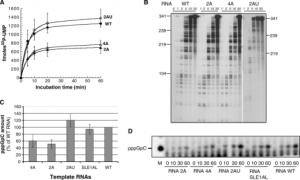Written by: The Midland Certified Reagent Company
Explore the process of RNA synthesis.
RNA, or ribonucleic acids, plays an important role in protein synthesis and the replication of DNA.
When the process of transcription first begins, the RNA polymers attach to a template strand of DNA and then begin to produce an RNA strand off a chain of nucleotides. There are different types of RNA that you should be aware of. The difference also lies in whether the RNA is in a prokaryote or a eukaryote.
The various types of RNA are made up of the different types of RNA polymerase. They are generally large enzymes that function as cell proteins. They play a vital role in the transcription process as they decide what is going to be coded as well as when the process is going to occur. These factors are crucial in the transcription process’s success. The adjunction of both of the strands determines the quality of synthesis.
DNA polymers on the other hand also play a role within the transcription process. DNA has the code for a cell’s sustenance. With that information within its structure, you’ll find them within the genes. In order for the instructions to be used, they must be coded in a way that cells can used to produce the proper proteins that promote continuous life.
DNA synthesis and RNA synthesis play a hand-in-hand role that is important for life’s patterns. Through these processes, one can achieve breakthrough contributions to today’s society which is why scientists and researchers continue to uncover new trends of both processes.